Ethnic Wear Market Summary, 2031
The global ethnic wear market size was valued at $89.3 billion in 2021, and is projected to reach $177.2 billion by 2031, growing at a CAGR of 7.2% from 2022 to 2031. The word "ethnic wear" refers to a particular style of clothing that is associated with a certain country or group of people. This kind of clothing displays a nation's traditions as well as the people's diverse and rich sense of fashion. Ethnic attire is anything that identifies a person as belonging to a certain ethnic group, from a single piece to an entire ensemble. People who belong to an ethnic group are those who have a common cultural background or historical tradition, typically tied to a particular region or linguistic history; occasionally, ethnic groups overlap with religious or professional groups. Ethnic dress includes both traditional and fusion clothing.
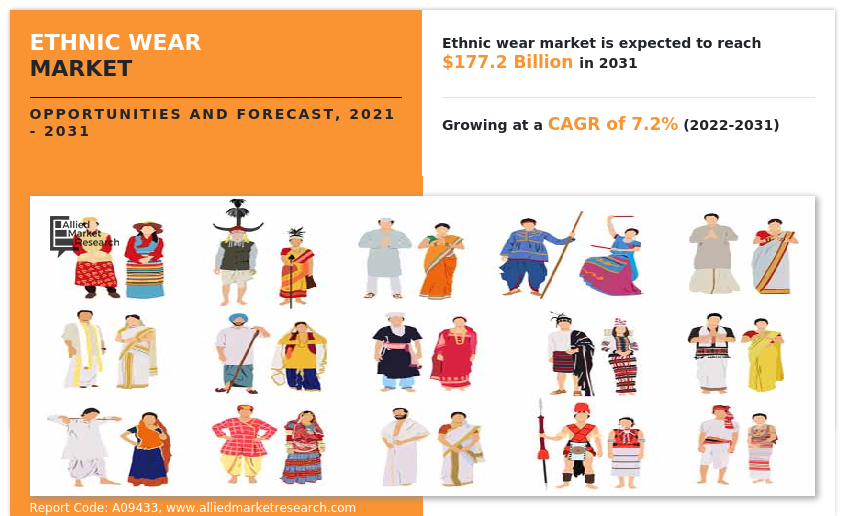
The Ethnic wear industry is projected to be fueled by increasing demand for fusion wear globally. The popularity of western clothes is rapidly rising, and with it the need for fusion ethnic apparel, where it has witnessed the emergence of mix-and-match styles that have fundamentally altered the market. Kurtis put over plain jeans, saris with crop tops, and lehengas coupled with shirts and T-shirts are all examples of fusion clothing.
Top competitors in the space, some of which are direct-to-consumer, fusion wear, ethnically diverse women with a range of body shapes, and engaging social media advertising. Thus, the demand for ethnic wear is on the rise.
Moreover, the rising number of fashion influencers is the major driver which propels the ethnic wear market demand. It is challenging to ignore the significance of influencers, particularly the micro-influencers who produce more logical and resonant content.
Because of their relatability, they have developed a genuine and devoted following that values their fashion and lifestyle judgements. In order to have a real presence in the social media community where they are in touch with their customers, brands are looking for this friendship between the two. Additionally, it helps a brand become more consumer-friendly and generate new products. The ability to communicate directly with customers is further fostering the market's expansion.
The ethnic wears are unique types of apparel with brilliant colors, patterns, and designs that are prized for their elegance and charm. The market for ethnic wear has continued to expand at a phenomenal rate as the apparel industry continues to push its own boundaries and broaden its market reach by connecting with the rest of the globe through e-commerce. For instance, a line of clothing that appealed to the global civilization and expanded the popularity of Indian ethnic wear in the global market merged the traditional elegance and luxury of Indian wear with the formality and comfort associated with western wear.
Moreover, innovative designs and digital marketing are creating many opportunities in the ethnic wear market. The apparel industry benefits from new designs, desirable fashion options, and effective marketing techniques. The availability of high-end brands and limited-edition goods has improved with customers' increased exposure to the internet and e-commerce.
Utilizing influencers has changed how beauty businesses sell their goods and attempt to boost sales. It is evident that marketers appreciate influencers because 71% of social media marketers say they have a budget for influencer marketing. Global clients are becoming interested in local firms with sustainable business models. Thus, such factors are creating various opportunities for the key players of the ethnic wear market globally.
However, less acceptance of ethnic wear in the corporate world is a factor hampering the growth of the market. The corporate sector has a lower level of tolerance for ethnic clothing, which would lower global demand. Because they are deemed to be informal in the corporate world, bright colors, bold patterns, and heavy designs are not permitted, which prevents people from wearing ethnic clothing to work, thereby hampering the global demand for ethnic wear industry.
The Ethnic wear market forecast is segmented on the basis of type, end user, distribution channel, and region. As per type, the market is classified into traditional wear and fusion wear. According to end user, the market is categorized into men, women, and kids.
By distribution channel, the market is classified into online and offline. Further, the offline segment is classified into specialty store, retail store, and others. Region wise, it is analyzed across North America (U.S., Canada, Mexico), Europe (Russia, Spain, Italy, France, Germany, UK, Rest of Europe), Asia-Pacific (China, Japan, India, South Korea, Australia, Rest of Asia-Pacific), and LAMEA (Brazil, Argentina, Chile, and Rest of LAMEA).
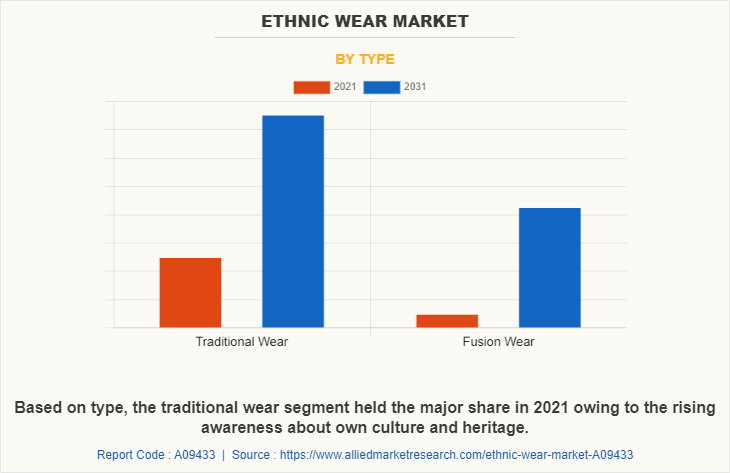
By type, the Ethnic wear market is segmented into traditional wear and fusion wear. The traditional wear segment accounted for a major share in the ethnic wear market in 2021 and is expected to grow at a significant CAGR during the forecast period.
The demand for traditional wear is rising due to rising awareness about culture and heritage. The customs and cultural values of a country can be seen in the clothing, which makes clothing an expression, image, and personality of that country.
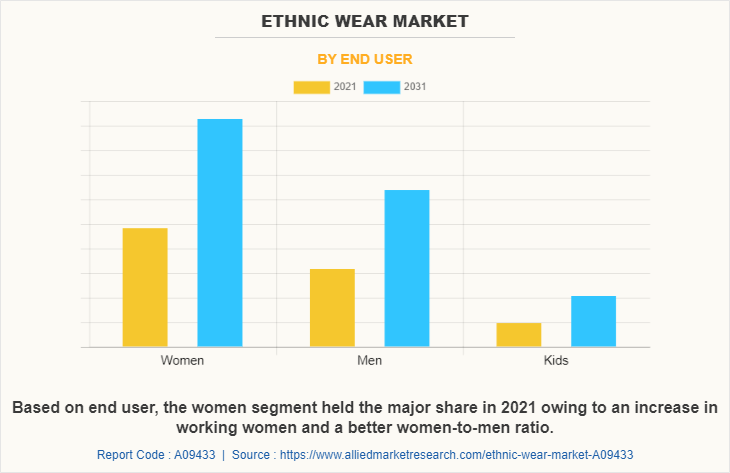
By end user, the ethnic wear market is segmented into men, women, and kids. The women segment accounted for a major share in the ethnic wear market in 2021 and is expected to grow at a significant CAGR during the forecast period.
Due to an increase in working women and a better women-to-men ratio, women are becoming more interested in ethnic clothing. The availability of specialized periodicals featuring the newest fashion statements, endorsement by well-known figures, and ongoing changes in apparel trends are all contributing to the segment's revenue development.
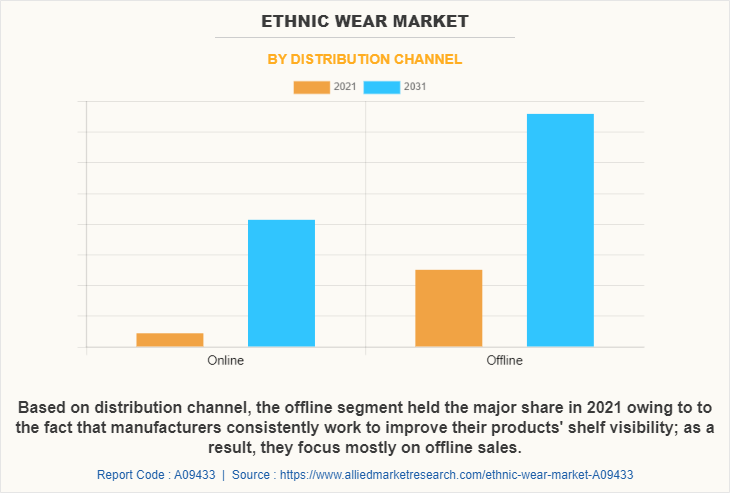
Based on distribution channel, the market is classified into Online and Offline. The Offline segment accounted for a major share in the ethnic wear market in 2021 and is expected to grow at a significant CAGR during the forecast period. Since the bulk of products are bought in offline stores and brand preference is easier to acquire in rural areas of developing countries, the offline market is crucial for customers living there. As a result, these elements are promoting market expansion.
Further, the offline segment is classified into specialty store, retail store, and others. The retail stores segment accounted for a major share in the ethnic wear market in 2021 and is expected to grow at a significant CAGR during the forecast period. Retail stores provide substantial discounts on a range of products. Retail stores' popularity among low- and middle-income social groups as a result of their wide selection of products offered at reasonably reasonable rates is what led to the current trend in the cosmetics industry.
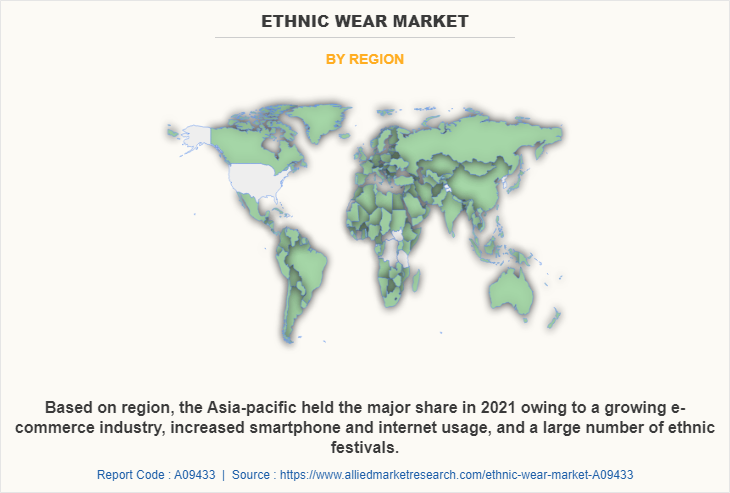
By region, the ethnic wear market is analyzed across North America, Europe, Asia-Pacific, and LAMEA. The Asia-Pacific ethnic wear market accounted for a major ethnic wear market share in the ethnic wear market in 2021 and is expected to grow at a significant CAGR during the forecast period.
The Asia-Pacific region is expected to witness robust ethnic wear market growth during the forecast period. India, which offers a vast variety of ethnic clothes, is one of the main contributors to the regional ethnic wear market. Over the course of the forecast period, the market for ethnic wear is anticipated to rise due to the rising popularity of Indian ethnic wear and the rising demand for it from the rest of the world.
The major players operating in the market focus on key market strategies, such as mergers, product launches, acquisitions, collaborations, and partnerships. They have been also focusing on strengthening their market reach to maintain their goodwill in the ever-competitive market. Some of the key players in the ethnic wear market include BIBA Apparels, Manyavar fashion private limited, thebe magugu, Afrikrea, Global Desi, ELIE SAAB, Modanisa, Fabindia, Rainandrainbow, Raymond Ltd, landmark group, W for Women, Diwansaheb, and Nesavaali.
Key Benefits For Stakeholders
This report provides a quantitative analysis of the market segments, current trends, estimations, and dynamics of the ethnic wear market analysis from 2021 to 2031 to identify the prevailing ethnic wear market opportunities.
The market research is offered along with information related to key drivers, restraints, and opportunities.
Porter's five forces analysis highlights the potency of buyers and suppliers to enable stakeholders make profit-oriented business decisions and strengthen their supplier-buyer network.
In-depth analysis of the ethnic wear market segmentation assists to determine the prevailing market opportunities.
Major countries in each region are mapped according to their revenue contribution to the global market.
Market player positioning facilitates benchmarking and provides a clear understanding of the present position of the market players.
The report includes the analysis of the regional as well as global ethnic wear market trends, key players, market segments, application areas, and market growth strategies.
Ethnic Wear Market Report Highlights
| Aspects | Details |
| Market Size By 2031 | USD 177.2 billion |
| Growth Rate | CAGR of 7.2% |
| Forecast period | 2021 - 2031 |
| Report Pages | 370 |
| By Type |
|
| By End User |
|
| By Distribution Channel |
|
| By Region |
|
| Key Market Players | Nesavaali Ltd., Rain & Rainbow, TCNS Clothing Co. Ltd., Thebe Magugu (Proprietary) Limited, Afrikrea, Ochre & Black Private Limited, Raymond Limited, Fabindia Limited, Landmark Group, Diwan Saheb Fashions Pvt. Ltd., ELIA SAAB, Vedant Fashions Limited, Modanisa Elektronik Magazacilik ve Tic.A.S., Newhanfu, BIBA Fashion Limited |
Analyst Review
According to the insights of the CXOs, the global ethnic wear market is expected to witness robust growth during the forecast period. More than ever, fashion companies and designers are experimenting with this style. Customers are wearing their kurtas with bottoms like harem pants, dhoti pants, and jeggings. It has been observed that a growing trend of women experimenting with fusion wear to express their individual sense of style due to its adaptability and ability to move from day to evening, casual to elegant. As a result, the market for ethnic wear is expanding due to the rising desire for fusion clothing. Furthermore, to attract consumers around the globe, key players in the market are investing in R&D activities and advertising & promotion of products.
CXOs further added about the booming clothing industry and rising number of fashion influencers are further boosting the market growth. Rapid digitization is causing the apparel sector to grow exponentially. Promotional initiatives and campaigns, whether online or offline, are increasing the demand for ethnic clothes among clothing retailers. The market for ethnic wear is being stimulated by advertisements, celebrity endorsement deals, fashion shows, and other promotional activities. However, Local manufacturers are using poor product quality materials for making ethnic wear is one of the factors which is expected to hinder market growth over the forecast period.
The global ethnic wear market size was valued at $89.3 billion in 2021, and is projected to reach $177.2 billion by 2031.
The top companies that hold the market share in the Ethnic wear market include BIBA Apparels, Manyavar fashion private limited, thebe magugu, Afrikrea, Global Desi, ELIA SAAB, Modanisa, Fabindia, Rainandrainbow, Raymond Ltd, landmark group, W for Women, Diwansaheb, and Nesavaali.
In 2021, Asia-Pacific accounted for 56.1% share in the global ethnic wear market and is expected to maintain its dominance during the forecast period.
The market for ethnic wear is mostly driven by the rising number of fashion influencers across the globe. It is difficult to overlook the importance of influencers, especially the smaller-scale influencers who provide more sensible and persuasive content.
The global Ethnic wear market registered a CAGR of 7.2% from 2022 to 2031.
Loading Table Of Content...
Loading Research Methodology...



